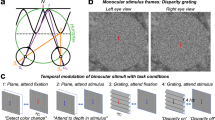Abstract.
The extraction of stereoscopic depth from retinal disparity, and motion direction from two-frame kinematograms, requires the solution of a correspondence problem. In previous psychophysical work [Read and Eagle (2000) Vision Res 40: 3345–3358], we compared the performance of the human stereopsis and motion systems with correlated and anti-correlated stimuli. We found that, although the two systems performed similarly for narrow-band stimuli, broad-band anti-correlated kinematograms produced a strong perception of reversed motion, whereas the stereograms appeared merely rivalrous. I now model these psychophysical data with a computational model of the correspondence problem based on the known properties of visual cortical cells. Noisy retinal images are filtered through a set of Fourier channels tuned to different spatial frequencies and orientations. Within each channel, a Bayesian analysis incorporating a prior preference for small disparities is used to assess the probability of each possible match. Finally, information from the different channels is combined to arrive at a judgement of stimulus disparity. Each model system – stereopsis and motion – has two free parameters: the amount of noise they are subject to, and the strength of their preference for small disparities. By adjusting these parameters independently for each system, qualitative matches are produced to psychophysical data, for both correlated and anti-correlated stimuli, across a range of spatial frequency and orientation bandwidths. The motion model is found to require much higher noise levels and a weaker preference for small disparities. This makes the motion model more tolerant of poor-quality reverse-direction false matches encountered with anti-correlated stimuli, matching the strong perception of reversed motion that humans experience with these stimuli. In contrast, the lower noise level and tighter prior preference used with the stereopsis model means that it performs close to chance with anti-correlated stimuli, in accordance with human psychophysics. Thus, the key features of the experimental data can be reproduced assuming that the motion system experiences more effective noise than the stereoscopy system and imposes a less stringent preference for small disparities.
Similar content being viewed by others
Author information
Authors and Affiliations
Additional information
Received: 2 March 2001 / Accepted in revised form: 5 July 2001
Rights and permissions
About this article
Cite this article
Read, J. A Bayesian model of stereopsis depth and motion direction discrimination. Biol Cybern 86, 117–136 (2002). https://doi.org/10.1007/s004220100280
Issue Date:
DOI: https://doi.org/10.1007/s004220100280




